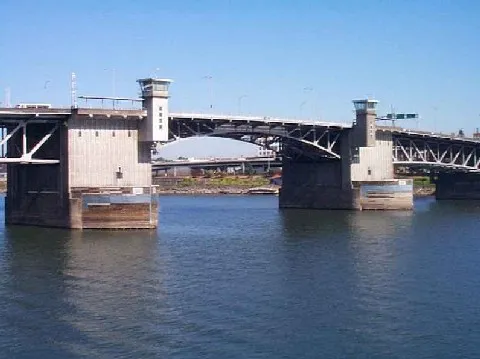Bridges come in many shapes and sizes. When you consider the types of materials used, the style of construction and the main use of the crossing, you find that bridges can take many forms. Bridges can be simple wooden beams over small streams or massive steel and concrete suspension structures crossing miles of open water and shipping channels. The best-known bridges in the Portland area span the Willamette and Columbia rivers, but there are also smaller structures that cross the Sandy River, Johnson Creek, Beaver Creek and other waterways, as well as roads, highways and railroads.

Bridges are of two general types: fixed and movable. Fixed bridges are usually classified by their basic geometry such as arches, trusses, beams, girder, suspension and cable stayed. Steel has been used in the construction of bridges for many years. Many small bridges today are constructed using concrete beams. Suspension bridges, whose decks are suspended from cables and towers, are used in locations where it is difficult to place piers. The St. John's Bridge is an impressive example of a steel suspension bridge.
Movable bridges are more complex structures having machinery for opening a portion of the bridge, allowing the passage of ships or other traffic through the bridge. Movable bridges are usually constructed at sites where there is not sufficient room or clearance for the construction of a larger structure. Types of movable bridges include vertical lift, swing and bascule.
Vertical lift bridges use cables, pulleys, motors and counterweights to raise a section of the bridge, much like an elevator. The Hawthorne Bridge is the oldest operating vertical lift bridge in the country today. Its main span can be raised 110 feet to allow vessels to pass underneath. The Steel Bridge is a double-decker vertical lift bridge which can raise its railroad level span independently of the higher street span.
Bascule bridges have spans that pivot upward utilizing gears, motors and counterweights. Unlike vertical lift bridges, when opened, there is no vertical obstacle to river traffic. The Broadway Bridge is an important example of a Rall-type, double-leaf bascule bridge. The machinery for opening the bridge is located above the structure. The Burnside Bridge is a Strauss-type, double-leaf bascule bridge. With this type of bridge, the machinery is located in the large pier structures, better protected from the weather.
Swing bridges rotate their spans on a pedestal, allowing vessels to move past on either side. They are now very rare, but were once commonly used to allow river traffic to pass at crossings that were too wide for a drawbridge. The Umpqua River Bridge in Reedsport, OR is an example of a pedestal swing bridge. The bridge features Oregon’s longest swing span and is the only swing bridge still operating in Oregon’s highway system.
We are very fortunate to have a wide variety of bridges located throughout the Portland area. The range of significant topographic features, rivers and streams has provided engineers throughout the years numerous opportunities and challenges for creating bridge structures of great beauty and versatility.
